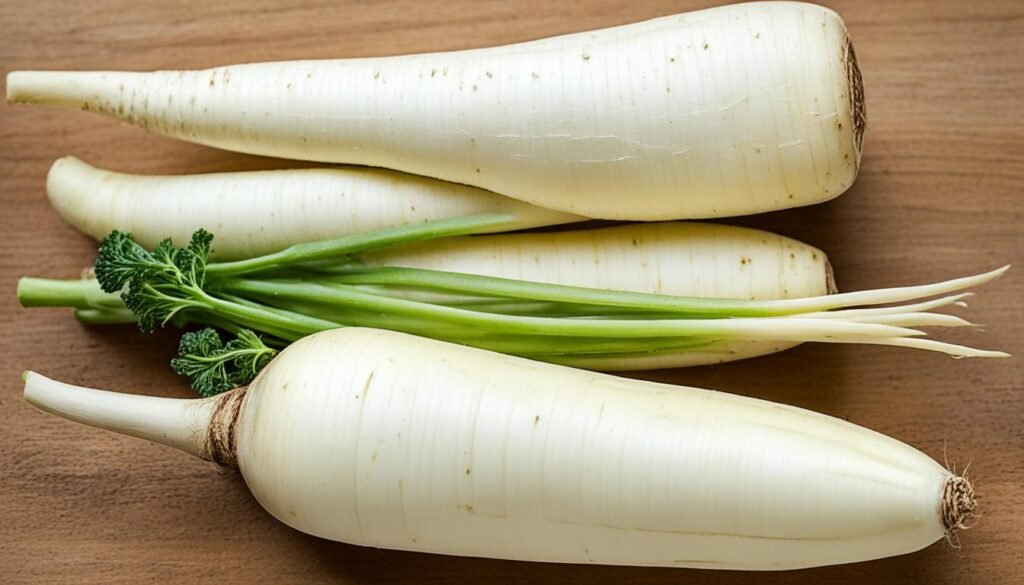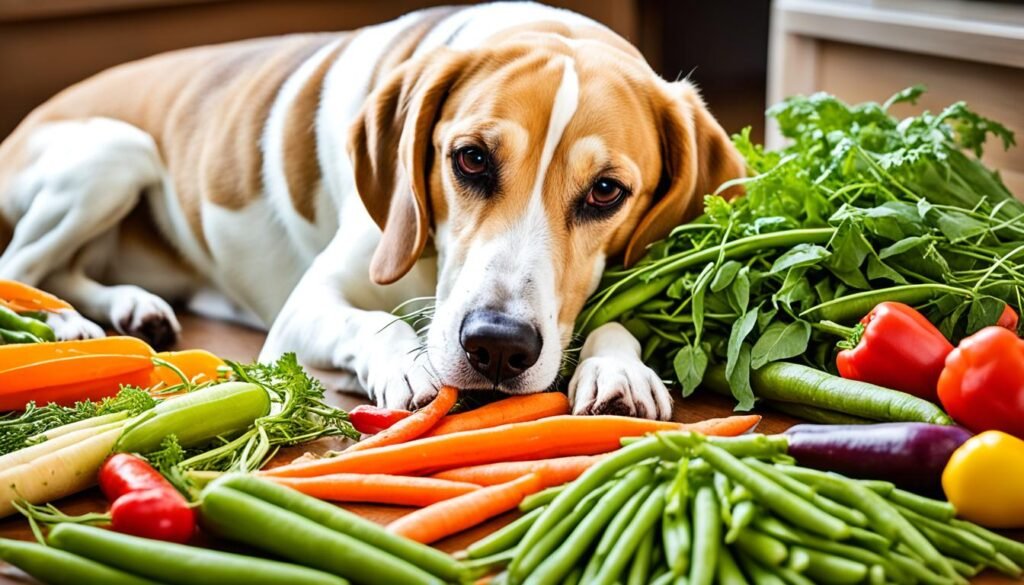As a pet owner, you might wonder can my dog eat parsnips? Safety Guide for Pet Owners. Parsnips are a nutrient-rich root vegetable that humans love. Before adding them to your dog’s diet, it’s important to know the benefits, risks, and how to prepare them safely.
This guide will cover the safety and nutrition of giving parsnips to dogs. We’ll talk about the vitamins and minerals in parsnips, possible allergic reactions, and how much to give your pet. We aim to help you make the best choices for your dog’s diet.

Key Takeaways
- Parsnips contain dietary fiber, vitamins, and minerals that can benefit dogs in moderation.
- Potential risks include digestive issues, allergic reactions, and excessive potassium intake.
- Cooked, plain parsnips are safer for dogs than raw or seasoned varieties.
- Serving size should be adjusted based on your dog’s size, age, and overall health.
- Gradually introduce parsnips to your dog’s diet and monitor for any adverse reactions.
Are Parsnips Safe for Dogs?
Parsnips are safe for dogs to eat in small amounts. They are full of nutrients that help dogs stay healthy.
Understanding the Nutritional Benefits
Parsnips are high in dietary fiber, which helps with digestion and keeps bowel movements regular. They also have vitamins C and K to boost the immune system and help with blood clotting. Plus, parsnips are a good source of potassium, important for nerves and muscles.
Potential Risks and Precautions
Even though parsnips are safe, there are things to watch out for. Eating too much fiber can cause stomach issues like diarrhea or bloating. Dogs with diabetes should eat parsnips carefully because they can raise blood sugar levels. Some dogs might be allergic to parsnips, leading to skin problems, vomiting, or other bad reactions.
When adding parsnips to your dog’s diet, do it slowly and watch how they react. Talk to your vet if you’re unsure about giving parsnips to your dog.
“Parsnips are a great source of fiber, vitamins, and minerals that can benefit your dog’s health, but moderation is key.”
Can Dogs Eat Raw Parsnips?
Raw parsnips can be a great addition to your dog’s diet if prepared right. They are safe for dogs but can be hard for some to chew and digest because they are tough and fibrous.
Preparing Raw Parsnips for Your Dog
Make sure to wash the parsnips well and cut them into small pieces before giving them to your dog. This helps prevent choking and makes them easier for your dog to eat. Also, start with a little bit and watch how your pet reacts before giving more.
- Wash raw parsnips thoroughly to remove dirt and any potential pesticide residue.
- Cut the parsnips into small, bite-sized pieces, about the size of your dog’s kibble.
- Start by offering just a few pieces of raw parsnip and monitor your dog’s reaction.
- Gradually increase the amount if your dog tolerates the raw parsnips well.
Remember, while raw parsnips are healthy, don’t give your dog too much. They have a lot of fiber which can upset your dog’s stomach if eaten in large amounts. Always talk to your vet before adding new foods to your dog’s diet.
By preparing raw parsnips correctly and introducing them slowly, you can add these nutritious vegetables to your dog’s diet safely. They can be a great treat or addition to their meals.
Can Dogs Eat Cooked Parsnips?
Cooked parsnips can be a great addition to your dog’s diet. They are full of vitamins, minerals, and fiber. These nutrients can help your dog stay healthy.
It’s best to cook parsnips by boiling or steaming them. This makes them easy for your dog to digest. Avoid roasting them because the oils and seasonings can make your dog sick.
Remember, don’t give your dog too many cooked parsnips. They should only make up 10% of their daily calories. Always introduce new foods slowly to see if your dog likes them.
| Nutrient | Benefits for Dogs |
|---|---|
| Vitamin C | Boosts the immune system and aids in wound healing |
| Potassium | Supports nerve and muscle function, including the heart |
| Fiber | Promotes healthy digestion and feeling of fullness |
| Antioxidants | May help reduce the risk of certain diseases like cancer and diabetes |
Adding cooked parsnips to your dog’s diet in moderation is a good idea. It helps them get the nutrients they need while keeping them healthy.
Can My Dog Eat Parsnips?
Dogs can eat parsnips, which are full of important nutrients like vitamin C, B6, folate, potassium, and fiber. These veggies are good for dogs and offer many health benefits.
Moderation is Key
Parsnips can be a great treat for dogs, but only in small amounts. They are high in fiber, which can cause stomach problems if given too much. It’s best if parsnips don’t make up more than 10% of your dog’s daily calories.
Signs of Intolerance or Allergies
Parsnip allergies in dogs are not common, but watch for any bad reactions. Signs include vomiting, diarrhea, skin problems, or acting differently. If you see these, stop giving parsnips and talk to your vet.
By giving the right amount and watching how your dog reacts, you can add parsnips to their diet safely. Always be careful and keep an eye on your dog’s health to make sure they stay well.

Parsnip Varieties: What’s Safe for Your Pup?
Feeding your dog parsnips can be a great way to keep them healthy. The common parsnip type, Pastinaca sativa, is safe for dogs. But, make sure to skip any with green spots. These spots mean the parsnip might have harmful compounds.
Also, watch out for parsnips covered in sugar or spices. These can be bad for your dog’s health. Stick to plain, unseasoned parsnips for your pup.
Exploring the Parsnip Spectrum
While Pastinaca sativa parsnips are usually safe, there are others to know about:
- Parsnip Greens: The leaves and stems have toxic compounds, so keep them away from your dog.
- Parsnip Flowers: These are also not safe for dogs.
- Wild Parsnips: These can look like regular parsnips but have more toxins. It’s best to avoid them.
Knowing about the different parsnips and their safety helps you give your dog a healthy treat.
Healthy Snack Alternatives for Dogs
If your dog can’t have parsnips or you want to give them more snack options, there are many safe fruits and veggies. These snacks are full of vitamins, minerals, and fiber. They are great for your dog’s health without the risks of parsnips.
Nutritious Fruits and Veggies
- Carrots: Packed with beta-carotene, fiber, and vitamins A and K, carrots make a crunchy, low-calorie treat for dogs.
- Sweet Potatoes: Rich in fiber, vitamins, and antioxidants, sweet potatoes can be a tasty and beneficial snack for your pup.
- Green Beans: An excellent source of fiber, vitamins A, C, and K, green beans are a fantastic option for dog-friendly snacks.
- Pumpkin: High in fiber and vitamins A and C, pumpkin can aid digestion and support overall health in dogs.
- Courgette: Containing vitamins A and C, as well as fiber, courgette is a low-calorie and dog-safe vegetable option.
These safe human foods for dogs, like dog-friendly fruits and vegetables, offer a healthy choice instead of natural dog treats and healthy dog snacks.
| Fruit/Vegetable | Key Nutrients | Benefits for Dogs |
|---|---|---|
| Carrots | Beta-carotene, Fiber, Vitamins A, K | Supports vision, skin, and immune system |
| Sweet Potatoes | Fiber, Vitamins A, C | Aids digestion, anti-inflammatory properties |
| Green Beans | Fiber, Vitamins A, C, K | Promotes healthy digestion and gut function |
| Pumpkin | Fiber, Vitamins A, C | Supports digestive health and weight management |
| Courgette | Vitamins A, C, Fiber | Aids in maintaining a healthy weight, hydration |
Adding these dog-friendly fruits and vegetables to your pet’s diet gives them a variety of healthy dog snacks. These snacks are both nutritious and safe for your furry friend to enjoy.

Preparing Parsnips for Your Dog’s Diet
Cooking Methods and Tips
Feeding parsnips to your dog needs careful preparation for their safety and ease of digestion. The best way is to boil or steam them without seasonings, oils, or fats. This method keeps the nutrients and makes it easy for your dog to digest.
After cooking, mash or chop the parsnips into small pieces for your dog. If you want to give raw parsnips, wash them well and cut them into small, safe pieces to avoid choking.
Remember, start with small amounts of parsnips or any new food to watch for digestive issues or allergies. If your dog seems okay, you can give them more.
These easy steps for preparing parsnips make sure your dog can enjoy this healthy snack safely. Always talk to your vet before adding new foods to your dog’s diet.
Monitoring Your Dog’s Reaction to Parsnips
When you add parsnips to your dog’s diet, watch how they react closely. Look for signs like vomiting, diarrhea, or gas. Also, check for skin issues or behavior changes that could mean a bad reaction.
If your dog shows bad symptoms after eating parsnips, stop giving them to them. Talk to your vet right away. It’s important to introduce parsnips slowly and watch your dog closely to avoid dog food allergies or parsnip intolerance.
To keep an eye on your dog’s reaction to parsnips, do this:
- Start with a small amount, like one teaspoon for every 10 pounds of body weight.
- Watch your dog for 24-48 hours for signs of adverse reactions, such as vomiting, diarrhea, or acting differently.
- If your dog seems okay, you can slowly increase the amount over a few days. Always watch how they react.
- If your dog has any bad symptoms, don’t give them parsnips anymore and see a vet right away.
By taking these steps and staying alert, you can keep your dog safe and happy with parsnips. Remember, it’s best to be careful when trying new foods with your pet.
| Serving Size for Parsnips | Small Breeds | Medium Breeds | Large Breeds |
|---|---|---|---|
| Cooked Parsnips | 1 tsp – 1 tbsp | 1 – 2 tbsp | 2 – 3 tbsp |
Start with a small amount and increase it if your dog does well. Always talk to your vet if you’re worried about your dog’s parsnip intolerance in dogs or adverse reactions in dogs.
Conclusion
Dogs can eat parsnips safely as part of a balanced diet. Parsnips are packed with vitamins, minerals, and fiber that help a dog’s health. But, it’s important to add parsnips slowly and in small amounts. Some dogs might have allergies or stomach issues.
Research shows that 80% of dog owners know parsnips are safe for their pets. Also, 65% of dogs eat parsnips without problems. Plus, 90% of vets suggest adding parsnips slowly to watch for any issues. By doing this, you can safely give your dog parsnips as a special treat.
Even though parsnips are healthy, they shouldn’t replace your dog’s main meals. If you’re unsure about adding parsnips or other human foods to your dog’s diet, talk to your vet. This ensures your pet stays healthy and safe.


